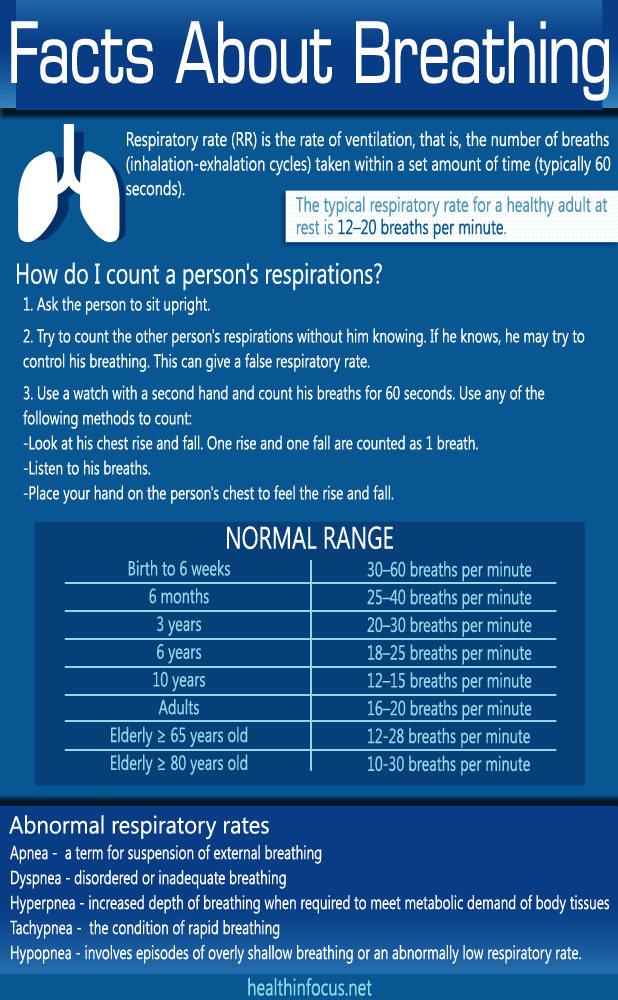 Infographic © healthinfocus.net
Infographic © healthinfocus.net
In order to detect or monitor health problems, medical professionals and healthcare providers take our vital signs – measurements of the body’s basic functions, which include the body temperature, pulse, respiration, and blood pressure. [1]
There are various types of breathing abnormalities. These are sometimes difficult for the person to self-monitor and may require medical monitoring if suspected. These include:
Apnea – suspension of breathing.
Dyspnea – disorderd or inadequate breathing.
Hyperpnea – increased depth of breathing when required to meet unusual metabolic demand.
Tachpnea – overly rapid breathing.
Hypopnea – episodes of overly shallow breathing or an abnormally low respiratory rate.
How To Count The Respiratory Rate [2]
The respiration rate is the number of times that a person breathes in and out per minute. Obtaining the respiratory rate can indicate whether an individual has any lung or respiratory problems. A change in their normal respiratory rate may indicate that their condition is either mending or worsening. [2]
1. Ask the person to sit in an upright position and relax.
2. Count the person’s respirations without his knowledge. Doing this may give you a more accurate respiratory rate, since the person is unaware and will not try to control his breathing.
3. Use a watch to count the number of breaths within one minute, or 60 seconds.
4. To count, use any of the following methods:
• Look at the chest as it rises and falls. One rise plus one fall is equal to one breath – i.e. one complete cycle.
• Listen to the person’s breathing.
• Place your hand on the person’s chest to feel the rise and fall.
Normal Respiratory Rates
The normal respiratory rate for an adult is between 12 to 20 breaths per minute; anything lower than 12 or higher than 25 while the person is resting is considered abnormal. [3]
Pay attention also to any noises that the person could make while breathing, such as wheezes, grunts, or gurgles, and check for cold, clammy skin, blue-tinged complexion and unusual dizziness – which may give further indications of what is happening. [2]
The following are considered the normal respiratory rates by age: [5]
• Birth to 6 weeks old: 30 – 40 breaths per minute
• 6 months old: 25 – 40 breaths per minute
• 3 years old: 20 – 30 breaths per minute
• 6 years old: 18-25 breaths per minute
• 10 years old: 17-23 breaths per minute
Abnormal Respiratory Rates
An unusually fast respiration may indicate pain or stress, or simply the result of a strenuous physical activity. Therefore a reading of ‘normal’ respiration should be done when a person has returned to “baseline” levels; not just after physical exertion. A person may also breathe rapidly when experiencing a fever or anxiety. [4] Other diseases that could change the normal respiratory rate of a person include asthma, pneumonia, congestive heart failure, lung disease, or drug overdose. [3]
Monitoring a person’s (and even your own) respiratory rate can help you keep track of health and spot early signs of illnesses – however for proper evaluation, professional medical consultation is advised. In cases where an abnormal respiratory rate and difficulty in breathing is observed, it is important to seek medical assistance promptly.
References:
[1] Vital Signs (Body Temperature, Pulse Rate, Respiration Rate, Blood Pressure)
https://hopkinsmedicine.org/healthlibrary/conditions/cardiovascular_diseases/vital_signs_body_temperature…/
[2] How to Count Respirations. https://www.drugs.com/cg/how-to-count-respirations.html
[3] Vital Signs. https://my.clevelandclinic.org/health/diagnostics/hic_Vital_Signs
[4] CNA Skill: Counts & Records Respiration Rate. https://cnatraininghelp.com/cna-skills/counts-records-respiration/
[5] Lindh, W., et al. 2009. Delmar’s Comprehensive Medical Assisting: Administrative and Clinical Competencies, p.573. https://books.google.com.ph/books?id=AUhJKmKJ_eEC&pg=PA573
★ Get My Books - 100% FREE:
😳 Tinnitus And Brain Health?
After 47 years of studies and countless brain scans done on more than 2,400 tinnitus patients, scientists at the MIT Institute found that in a shocking 96% of cases, tinnitus was actually shrinking their brain cells.
As it turns out, tinnitus and brain health are strongly linked.
Even more interesting: The reason why top army officials are not deaf after decades of hearing machine guns, bombs going off and helicopter noises…
Is because they are using something called "the wire method", a simple protocol inspired by a classified surgery on deaf people from the 1950s...
★ How To Get Rid Of Nail Fungus:
★ Does Your Salad Contain This Vegetable?
★ 20 Natural Painkillers In Your Kitchen (Video):
★ Men's Prostate Health:

2. Famous Chef Sheds 60lbs Researching New Paleo Recipes: Get The Cookbook FREE Here
3. #1 muscle that eliminates joint and back pain, anxiety and looking fat
4. 7 odd foods that KILL your abdominal fat (surprising fat-fighters)
5. The TRUTH about bread (Will surprise you!)
6. [PROOF] Reverse Diabetes with a "Pancreas Jumpstart"
7. Here's What Happens When You "Unlock Your Hip Flexors"
8. The #1 WORST food that CAUSES Faster Aging (beware -- Are you eating this?)
The #1 Muscle That Eliminates Joint And Back Pain, Anxiety And Looking Fat
By Mike Westerdal CPT
Can you guess which muscle in your body is the #1 muscle that eliminates joint and back pain, anxiety and looking fat?
This is especially important if you spend a significant amount of time sitting every day (I do, and this really affects me in a big way!)
Working this "hidden survival muscle" that most people are simply not training because no-one ever taught them how will boost your body shape, energy levels, immune system, sexual function, strength and athletic performance when unlocked.
If this "hidden" most powerful primal muscle is healthy, we are healthy.
Is it...
a) Abs
b) Chest
c) Glutes
d) Hip Flexors
Take the quiz above and see if you got the correct answer!
P.S. Make sure you check out this page to get to know the 10 simple moves that will bring vitality back into your life:
If you enjoyed this page:














